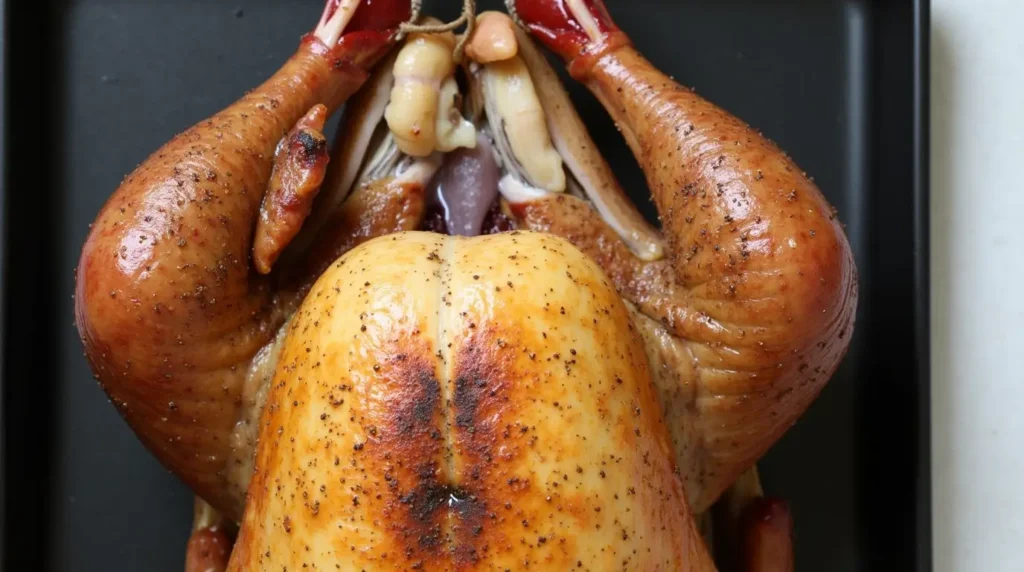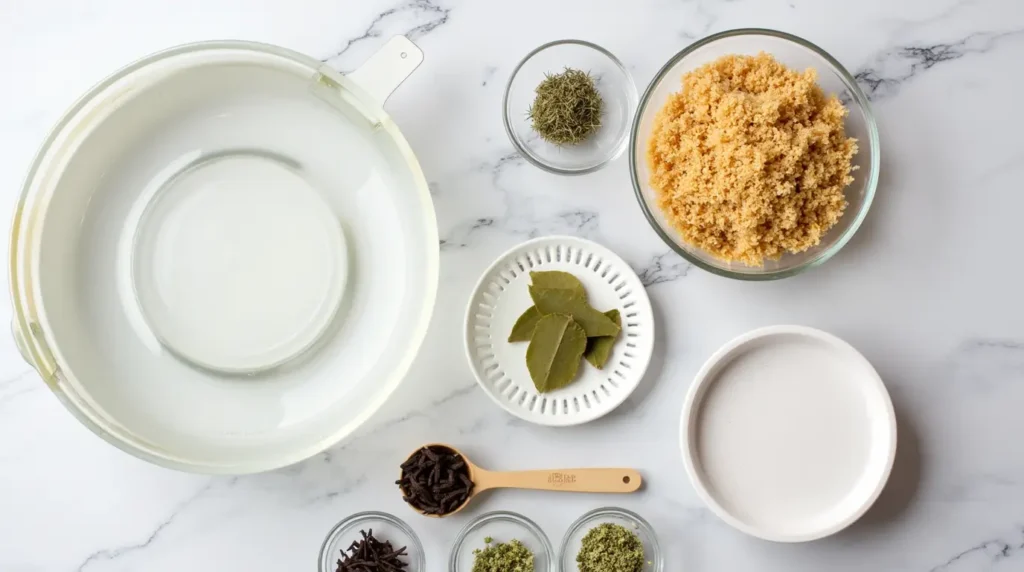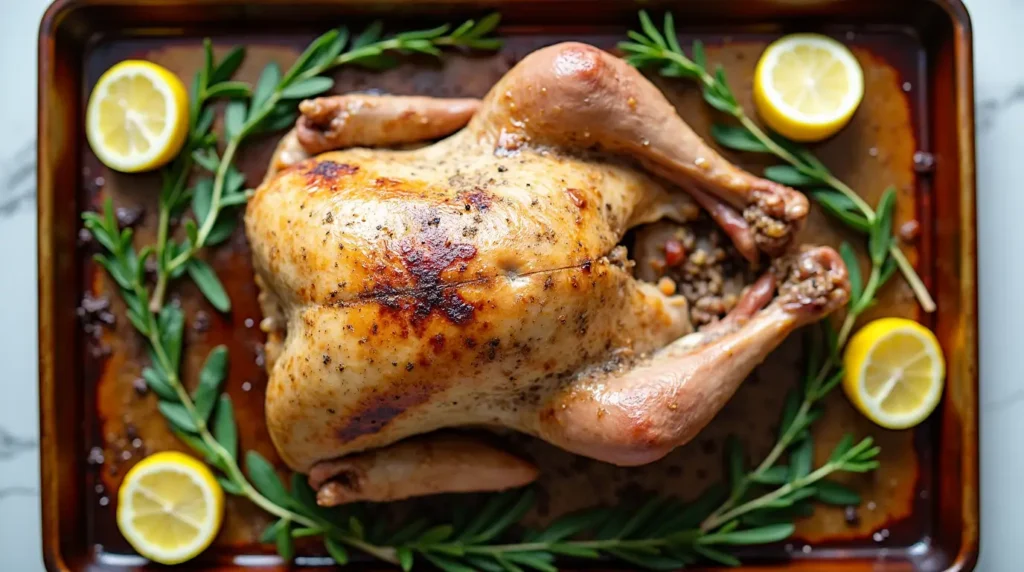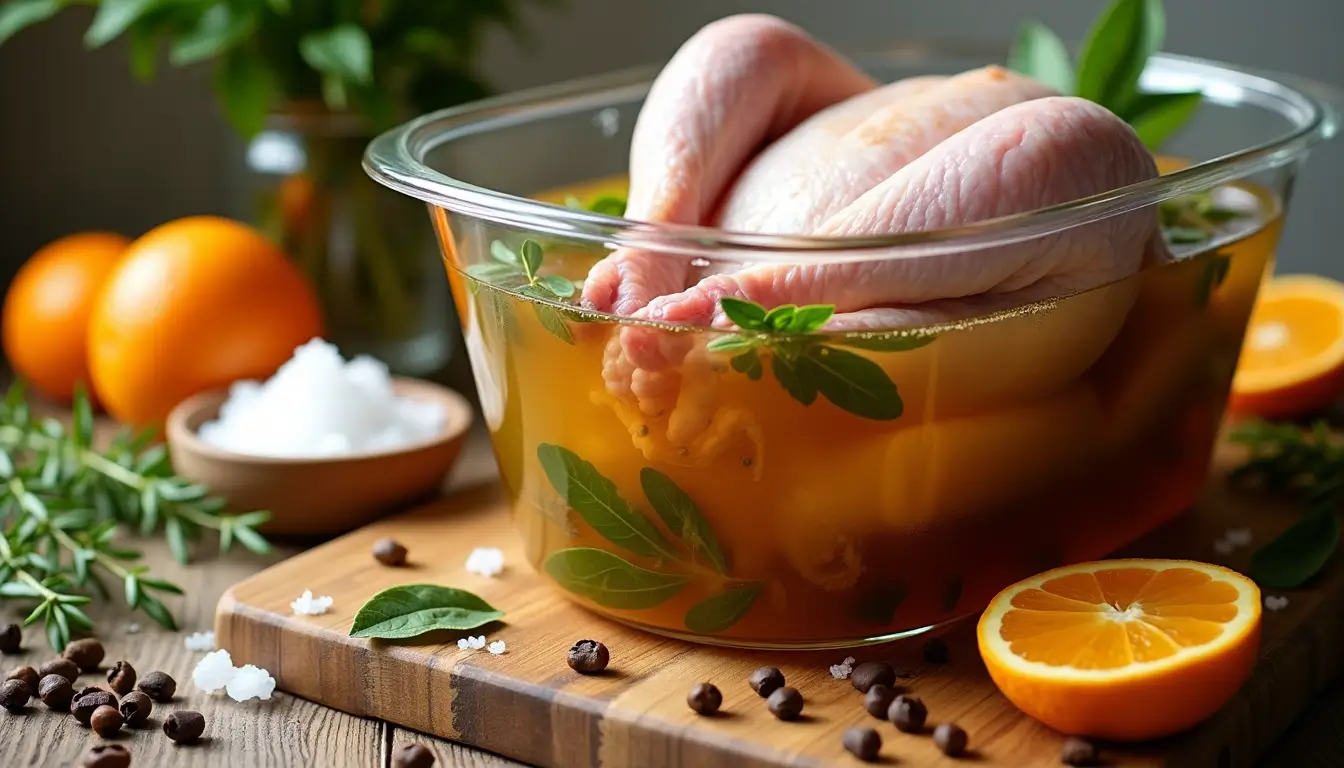Did you know that 8 out of 10 holiday turkey complaints are about dry, tasteless meat?
Many of us know the frustration of spending hours in the kitchen only to serve a turkey that’s as dry as cardboard. The good news? A simple turkey brine recipe can revolutionize your bird from bland to grand without much effort.
Brining works like an insurance policy for your turkey. This straightforward technique helps your turkey retain moisture and absorb flavor. The process makes it almost impossible to end up with dry meat. You don’t need to be a cooking expert to achieve great results.
Your experience level doesn’t matter – whether this is your first turkey or you want to improve your usual recipe. We’ll guide you through making turkey brine recipe that guarantees a juicy, flavorful feast. Let’s take a closer look at the simple steps that will make your next turkey the talk of the table!

Table of Contents
Essential Brine Ingredients for Maximum Flavor
The right ingredients and proportions make the difference between a good turkey and a great one. Let’s dive into what makes a successful turkey brine recipe work.
Basic Brine Ratio and Components
A perfect turkey brine needs 1 cup of kosher salt per gallon of water. Kosher or sea salt works best – skip the table salt since iodized versions can leave your turkey with an unwanted metallic taste. Brown sugar adds sweetness to our simple mixture and helps achieve better browning.
Flavor Boosters and Aromatics
Your Turkey Brine Recipe becomes truly memorable with these vital aromatics:
- Whole garlic heads and bay leaves to add savory depth
- Fresh thyme and rosemary sprigs
- Whole black peppercorns
- Worcestershire sauce to bring umami notes
Budget-Friendly Ingredient Substitutions
Fresh herbs can get pricey, but here’s the good news: dried herbs work just as well in a brine. You can use 1 tablespoon dried rosemary and 2 teaspoons dried thyme instead of fresh herbs. To name just one example, see how apple juice makes a cost-effective substitute for apple cider.
Keep in mind that your turkey needs enough liquid for complete coverage. The salt ratio must stay consistent – another gallon of water means another cup of salt to maintain the right balance.
Many recipes suggest complex spice combinations, but salt and water ratio is the vital part. Other aromatics will boost the flavor, yet salt does the real work to keep your turkey moist and flavorful.

Quick Brining Method for Last-Minute Prep
Short on time? Here’s our quick turkey brine recipe that gives you amazing results in just a few hours.
Speed Brining Technique
You can speed up the whole brining process to just 3-4 hours at room temperature. A 10 percent brine solution works faster than the traditional ratio. This stronger mix helps the brine do its job much quicker.
Temperature Control Tips
We take safety seriously with speed brining. Here’s what we know about keeping the right temperature:
- The brine temperature should stay between 35-40 degrees F
- Ice packs help maintain steady temperature
- Cold brine is essential – warm brine can let bacteria grow
- Check the temperature often during the process
Time-Saving Shortcuts
We’ve found that brined turkeys cook 20-30 minutes faster than unbrined ones, which saves you extra time. The quickest way to get started is to dissolve the sugar in boiling water before adding cold water and ice.
It’s worth mentioning that safety comes first, even as we speed things up. If you’re using a cooler, wrap the brining bag around the turkey and pour ice over it to avoid dilution. This keeps the brine strength perfect and everything stays safely cold.
Note that even a quick brine makes your turkey taste better. Just don’t leave it too long, or your turkey might end up too salty. Once you’re done, pat the turkey dry and cook it your favorite way.
Step-by-Step Brining Process
Let’s walk through the exact steps to create our turkey brine recipe with all our ingredients ready.
Preparing the Brine Solution
The process starts with boiling 2 cups of water for each gallon needed. Here’s a simple process that works every time:
- Dissolve salt in hot water
- Add chosen aromatics and spices
- Cool mixture to room temperature
- Add remaining cold water
- Make sure the solution is completely cold before use
Submerging the Turkey
Proper submersion is a vital part of even brining. Start by removing giblets and rinsing the turkey under cold water. You’ll need one of these containers:
- Food-grade bucket or brining bag
- Stainless steel stockpot
- Large roasting bag in a pan
Note that you should never use household trash bags or non-food-grade containers.
Monitoring and Flipping Guidelines
A strict schedule ensures perfect results. The turkey needs to stay submerged for 12 to 24 hours, with temperatures steady between 35-40°F. The turkey should be flipped halfway through for even brining.
A helpful tip: place a clean plate on top if your turkey floats to keep it fully submerged. Once brining is complete, rinse the turkey really well under cold water and pat it dry with paper towels.
The sink needs a good cleaning afterward to avoid cross-contamination. The brined turkey should rest on a roasting rack up to an hour before cooking to achieve the crispiest skin.

Common Brining Mistakes to Avoid
Many people mess up turkey brining, but you can avoid these mistakes with the right know-how. Let’s look at the most common problems and their solutions.
Salt Concentration Errors
The right salt ratio is a vital part of our turkey brine recipe. We stick to 1 cup of kosher salt per gallon of water for wet brining, or 1 tablespoon of salt per 5 pounds for dry brining. Your turkey will taste bland with too little salt and become inedible with too much. The bad news? You can’t fix a turkey that’s been over-brined.
Temperature Control Issues
Food safety depends on proper temperature control. Here’s what experience has taught us:
- The brine temperature must stay below 40°F
- Room temperature brining is never okay
- You need to watch ice levels if using a cooler
- Add more ice whenever needed to keep it cold
Bacteria grow faster in temperatures between 40-140°F. The right temperature becomes even more important during longer brining times.
Cross-Contamination Risks
We take no chances with cross-contamination. The sink area needs to be clear before you handle the turkey. These steps are vital:
- Clean and sanitize all surfaces first
- Keep brining containers separate
- Clean every container that touched raw turkey
- Sanitize all counters and sinks afterward
Here’s a significant tip: don’t wash the turkey before brining because harmful bacteria can splash around. Focus on temperature control and careful handling instead.
Note that pre-injected or self-basted turkeys already contain salt solution. Skip the brining step with these turkeys to avoid ruining the meat with too much salt.

Conclusion
A perfectly brined turkey delivers juicy, flavorful results that will impress your guests every time. Over the last several years, we’ve discovered the quickest way to achieve this – use the right salt-to-water ratio, control the temperature properly, and avoid mistakes that could spoil your Turkey Brine Recipe.
Our proven brine recipe gives excellent results with either the traditional 24-hour method or a quick 3-4 hour solution. The difference between a memorable feast and food safety concerns lies in how well you monitor temperature and maintain proper sanitation.
The recipe’s success depends on three essentials: exact measurements, steady temperature checks, and proper handling. Once you become skilled at these fundamentals, your turkey will stay moist and flavorful with every slice.
Your turkey deserves this extra attention. The simple recipe serves as your starting point. Add different aromatics to experiment, and your turkey will become the highlight of many memorable meals to come.
FAQs
Q1. What is the ideal salt-to-water ratio for turkey brine recipe? The ideal ratio is 1 cup of kosher salt per gallon of water. This concentration ensures proper flavor absorption without oversalting the meat.
Q2. How long should I brine my turkey? For best results, brine your turkey for 12 to 24 hours. If you’re short on time, a quick brine of 3-4 hours can still improve flavor and moisture.
Q3. Can I use table salt instead of kosher salt for brining? It’s best to avoid table salt for brining. Kosher or sea salt is preferred as iodized salt can impart an unwanted metallic taste to the turkey.
Q4. What temperature should the brine be kept at during the process? Maintain the brine temperature between 35-40°F (1.7-4.4°C) throughout the brining process to ensure food safety and prevent bacterial growth.
Q5. Are there any alternatives to fresh herbs for flavoring the brine? Yes, dried herbs can be used as a budget-friendly alternative. For example, you can substitute 1 tablespoon dried rosemary and 2 teaspoons dried thyme for fresh herbs in your brine recipe.

